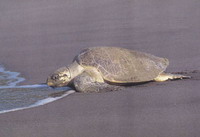Lora turtle under protection of Costa Rican residents
Ostional beach residents dedicated themselves to taking care of the nesting grounds for the lora turtle.

The beach on Costa Rica's Pacific coastline is one of three places in the world where large numbers of the turtles can be found. The others are in Mexico and India.
A few years ago, the turtles only occupied about a kilometer (about a half mile) of the beach. Today, you can find them along a 7-kilometer (4-mile) stretch.
Gerardo Chaves, a biologist at the University of Costa Rica who has studied the turtles for 11 years, said the population has increased significantly and some 1 million turtles migrate to the beach at certain points of the year.
"The turtle returns to the beach where it is born, and the problem in Ostional now is that the beach can't support so many and that could limit the growth of the species," he said. "That is why man's role is so important."
Chaves said the nearby residents help clean the beach and patrol for predators as baby turtles hatch and head toward water, ensuring a 10 percent increase in the survival rate of the animals.
"These are positive conservation results that should be used as a model" for other areas, he said.
In return for their trouble, the residents are allowed to collect a small portion of the first turtle eggs laid on the beach, many of which would be destroyed by the next wave of nesting turtles.
During each of the two large nesting periods a year, "We take an average of 500,000 eggs, which is less than 1 percent of the total," said Gilberto Rojas, president of the conservation program. "We sell them in bags of 200 eggs, each of which costs about US$12.50." ( about 8.40 EUR).
The program gets an exemption from Costa Rica's usual prohibition against any sales of turtle eggs, which were long a local delicacy.
The community of about 900 people began protecting the turtles since 1984.
Subscribe to Pravda.Ru Telegram channel, Facebook, RSS!


